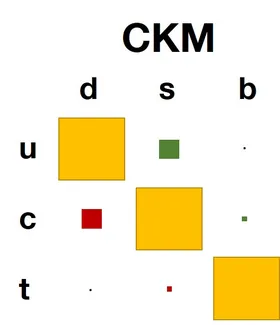Flavour Physics

Nature presents us with three generations of fundamental particles, including the six flavour – up/down, charm/strange and top/bottom – of quarks. While only the particles of the first generation are directly relevant to the world around us, the very existence of three generations leads to a number of profound and subtle phenomena such as: the violation of charge conjugation and space-time parity as well as microscopic time-reversal invariance, the possibility to generate an asymmetry between matter and antimatter in the cosmos, and particle-antiparticle oscillations of mesons. In the Standard Model of particle physics, the three generations are distinguished by their Yukawa couplings to the Higgs field, which give different masses to the particles and allow for transitions between particles of the different generations, quantified by the Cabibbo-Kobayashi-Maskawa matrix for quarks (and a similar matrix for neutrinos). For unknown reasons, the CKM matrix is nearly diagonal (see figure), but the small off-diagonal elements give rise to a rich phenomenology, encompassing CP violation in Kaon and B-meson systems as well as numerous testable meson production and decay modes. However, the underlying theoretical foundation and pattern of the Yukawa coupling matrices belongs to the topics within particle physics that are least understood.
The observational progress in flavour physics, related to the LHC program and the LHCb experiment as well as B-factories such as Belle II or SuperKEKB require us to obtain precise predictions for extracting fundamental parameters from flavour observables. A challenge in this area is the treatment of the non-perturbative dynamics of Quantum Chromodynamics (QCD) at the confinement scale, alongside the perturbative process of flavour-changing transitions mediated by the weak force. The T31 group focuses on the study of B-mesons (made of the heavy thrid-generation b-quark and a light quark) and develops systematic factorization methods based on soft-collinear effective theory (SCET) allowing for a separation of non-perturbative long-distance effects from perturbative short-distance processes. This enables first-principles calculations and fundamental physics test from measurements that would otherwise be difficult to interpret theoretically. Specific topics pursued in the group are:
- B-meson decays into two mesons with QCD factorization/SCET methods
- Direct CP violation in B decays
- Radiative (semi-) leptonic B-meson decays
- Developments of methods to calculate corrections to the heavy-quark limit
- Theory of structure-dependent electromagnetic effects
- Light-cone distribution amplitude of the B-meson
You can find a list of publications from T31 in the INSPIRE HEP database
You can find information on master and bachelor thesis topics here